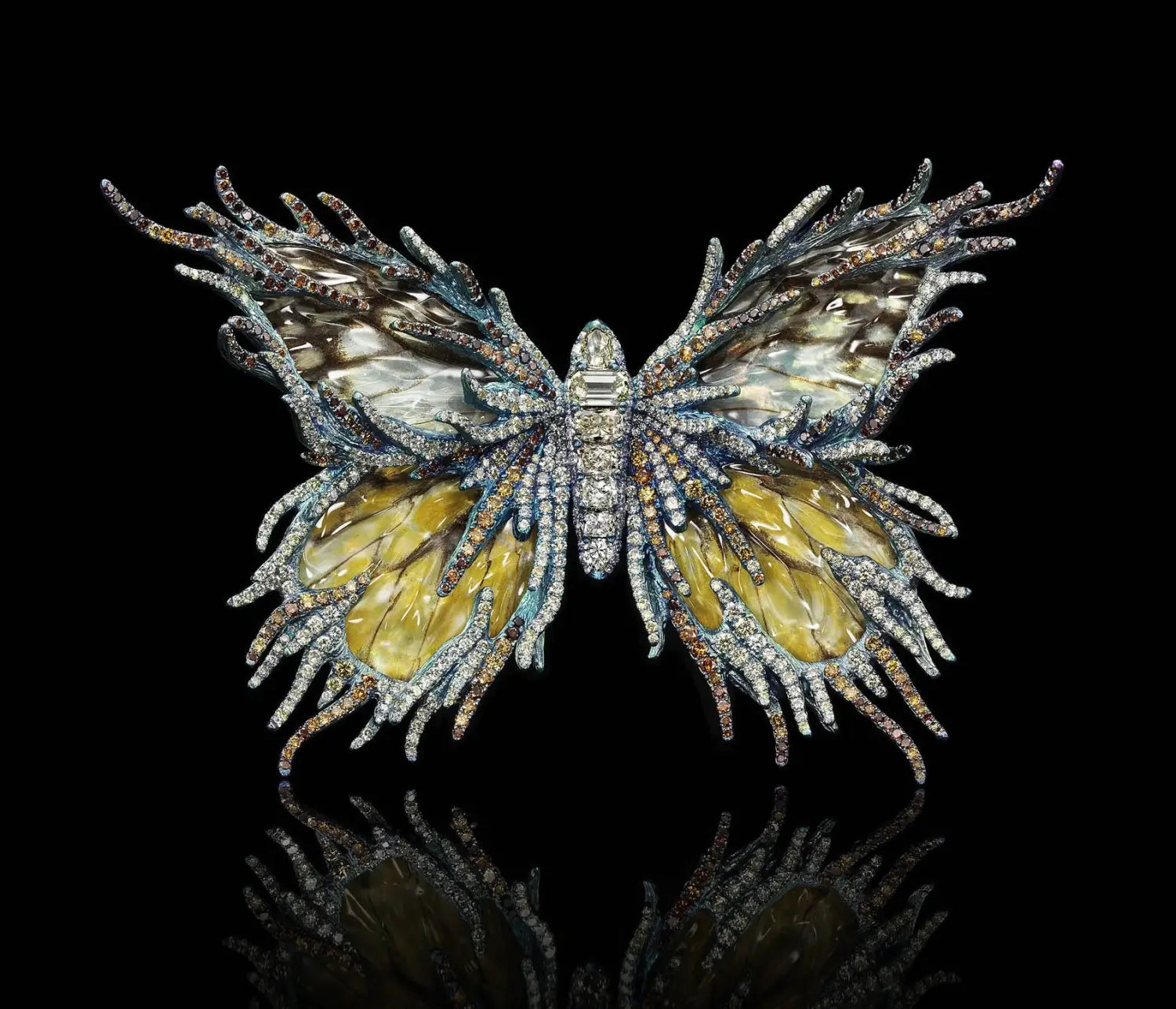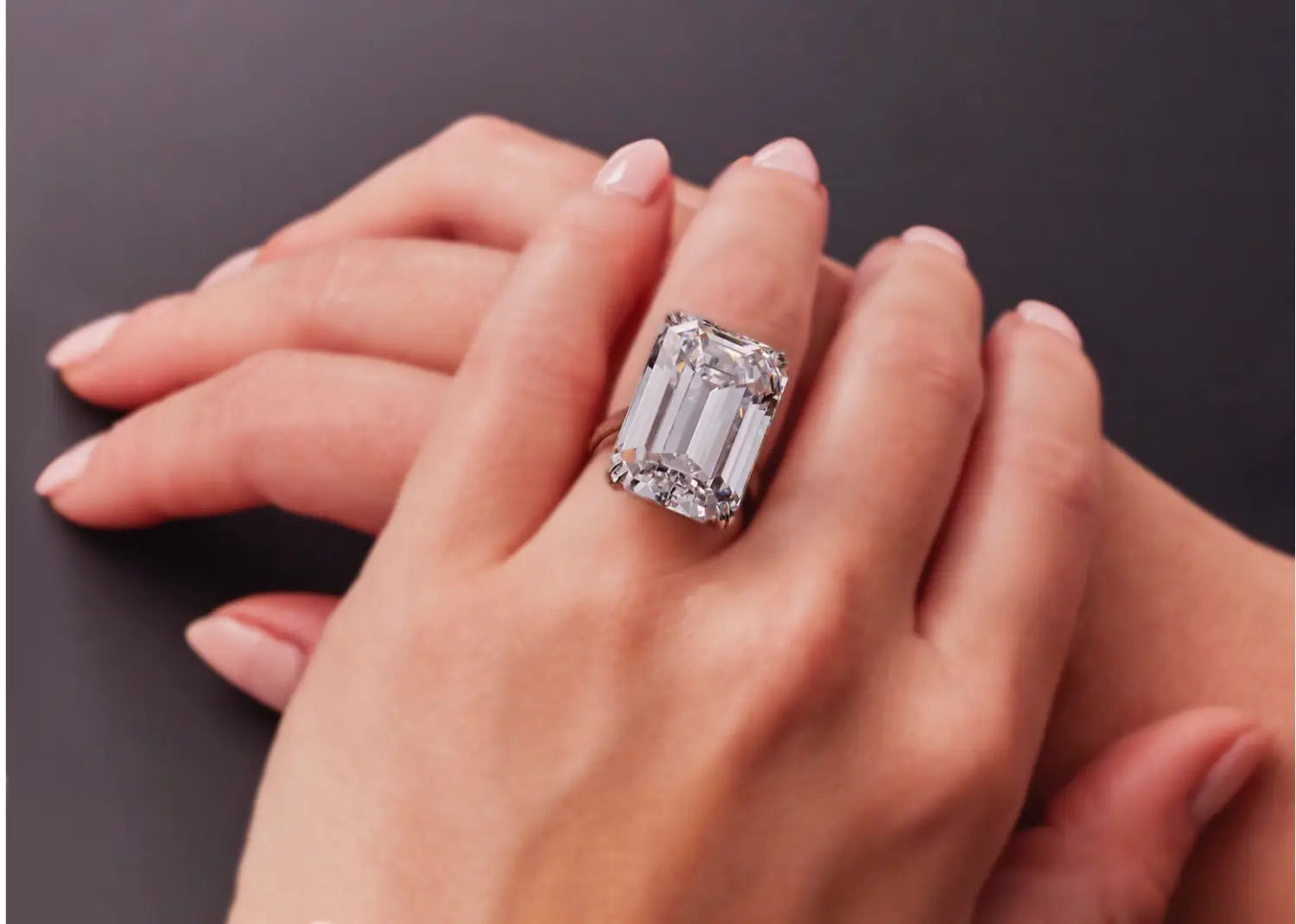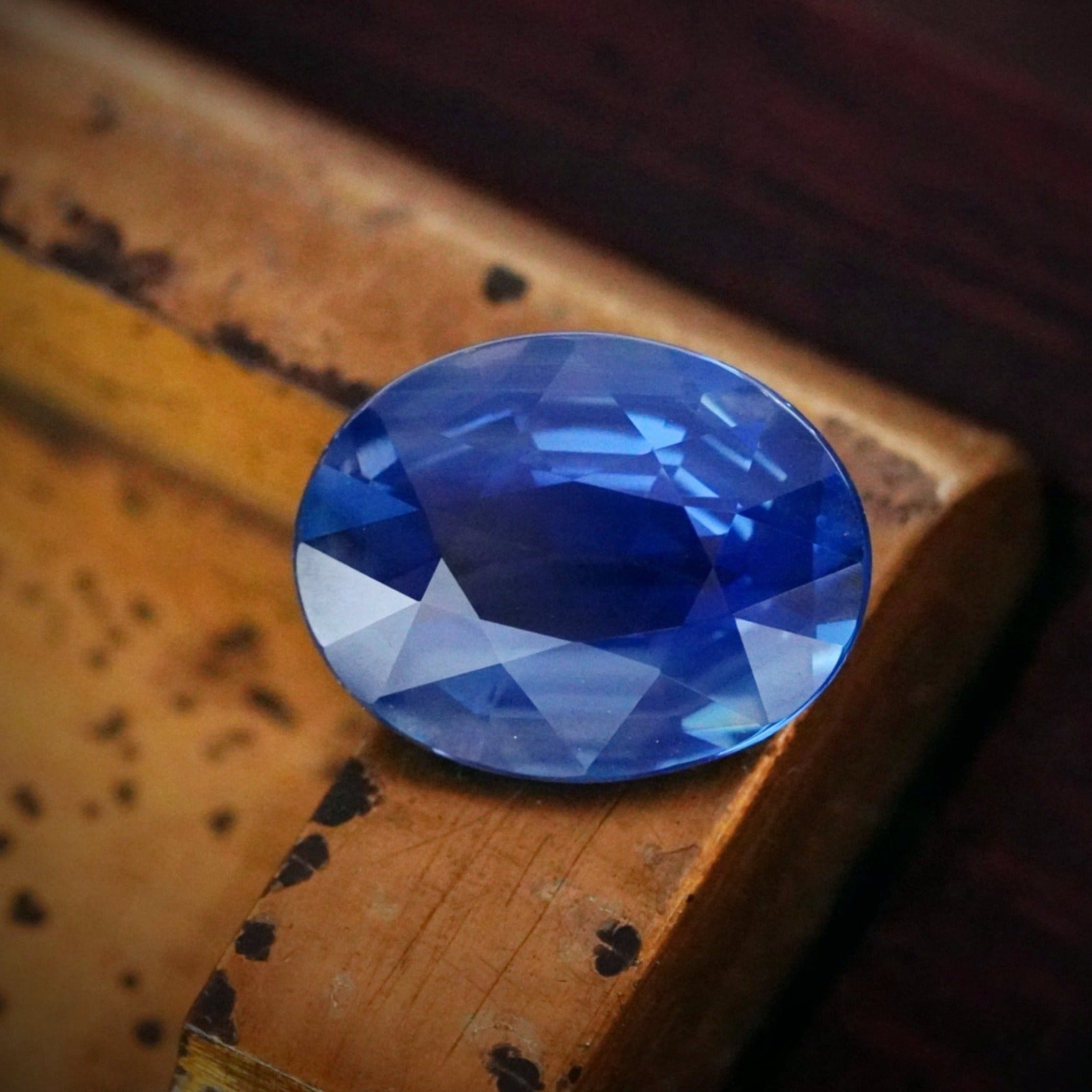
Wallace Chan’s Jeweled Art Transcends the Imagination
To behold a piece of Wallace Chan jewelry is to recall the famous words of American author Napoleon Hill: “Whatever the mind of man can conceive and believe, it can achieve.” Chan’s deep desire to express the fullness of his imagination has inspired an artistry and innovation so incomparable, that his jeweled creations transport you to a place where dreams are born.

Master jeweler Wallace Chan.
Chan first tapped into his passion at the age of 16, when he became a sculptor’s apprentice in Hong Kong after he had left school to support his family. He began by carving traditional Chinese figures; then opened his own workshop a year later to further his craft and travel the world. Chan then committed himself to many years of mastering the techniques of Eastern sculpture, the gemstone-cutting skills of the West and numerous European arts.
Of particular interest to Chan were the techniques of intaglio (a design engraved into a gemstone) and cameo (essentially the opposite of intaglio, a gemstone carved in relief). Also of interest to Chan was diamond cutting. He was intrigued by the discovery that when light enters a diamond, the resulting colors and reflections interact with each other and create different effects.
The Wallace Cut
Combining these interests, Chan debuted “The Wallace Cut” in 1987. Inspired by a multiple-exposure image at a photography exhibit, Chan invented the gem-carving technique. It involves carving a three-dimensional figure through the back of a transparent gemstone in line with the angles of the gem’s facets, so that when light enters the stone, the figure is reflected multiple times. The effect is nothing short of astonishing.
In Chan’s “Now and Always” necklace, for example, we see the exquisite personification of the Horae, Greek goddesses of the seasons, carved within an aquamarine as one face with four reflections. The piece, which took Chan two years to complete (not including the years he spent perfecting the carving technique), was one of Chan’s greatest challenges and confirmed his status as a master sculptor.

The "Now and Always" necklace featuring "The Wallace Cut."
“To get a full-bodied, three-dimensional face for this work, I had to empty out precisely just such a face from the back [of the gemstone],” Chan says. “Since it was carved in reverse, every cut was an act of reverse-thinking: left is right, deep is shallow and front is back. I also had to do many calculations to determine where the center of the face would be and the amount of space needed for each half of the face since both sides had to be symmetrical. Then I had to consider the angles of the facets on the periphery of the face to achieve the number of reflections I wanted.”
To add to the complexity, the carving tools Chan needed for the piece weren’t sophisticated enough at the time, so he apprenticed at a factory to learn how to create them. After six months at the factory, Chan discovered he could use a dentist’s drill, but its rotation was too fast, and the heat it generated while carving would crack the stone. At last Chan realized he had to do the carving with the stone under cold water.
“So there I went, carving under water, drying the stone and then checking to see if it was alright. (I couldn’t clearly see when I was carving, and one tiny mistake would be reflected four times and the whole work would be ruined.) Then I put the stone back into water and carved again,” Chan says. “It was a stroke by stroke process. In the end, I felt that my mind, my hand and the tool were all working as one; it was my consciousness doing the carving. I surrendered myself to the magic of light and shadow and found great happiness in it.”
All who see the piece delight in it as well. In fact, “The Wallace Cut” led Chan to a solo exhibition at the Deutsches Edelsteinmuseum (German Gemstone Museum) in Idar-Oberstein, Germany, in 1992, where he was named the “Carving Prodigy from Asia.” Renowned jewelry historian Vivienne Becker also considers “The Wallace Cut” one of the 100 most important jewels of the 20th century.
Gem-Setting Innovations
After the creation of “The Wallace Cut,” Chan entered what he calls his Buddhist art stage from 1996–2000, where he worked on large-scale sculptures, often for revered monasteries. He met Yih Shun Lin, a Taiwanese art collector, who became his mentor and patron. Lin enlisted Chan to create his “Great Stupa,” a shrine of gold, crystal and gemstones to house Buddha’s tooth, now on permanent display at the Fo Guang Shan Buddha Memorial Center in Taiwan.
These experiences opened a new chapter of jewelry creation for Chan. He began exploring such things as metallurgy and new gem-faceting techniques to give form to his Zen-stimulated mind. Among his discoveries was a refining and brightening technique for jadeite, China’s most precious gemstone, for which he received a patent in 2002. This technique sends light racing and pulsating along jadeite’s green surface, with refractions magnifying and sharpening the deep green hues.

The "Stilled Life" brooch featuring Wallace Chan's refining and brightening technique for jadeite, as well as his "inner mortise and tenon setting method."
The technique is best displayed in Chan’s “Stilled Life” brooch, which centers on the cicada insect, regarded for thousands of years by the Chinese as a powerful symbol of rebirth. As light spans across the cicada’s Imperial jadeite wings, for instance—which are a pure, penetrating green with an alluring brilliance and texture—they appear as if fluttering in the sunlight.
The brooch also showcases another of Chan’s innovations—the “inner mortise and tenon setting method”—a gem-setting technique inspired by the mortise and tenon joints found in furniture of the Ming Dynasty from the 15th–17th centuries.
“The inner mortise and tenon setting method adopts a joining method of Ming-style architecture, in which materials such as diamonds and jade are given a special cut to form a mortise and tenon joint so that they become a perfect fit without the use of a claw setting,” Chan says. “This was also invented to minimize the visibility of the metal.”
Along these lines, Chan also devised his “diamond claw setting method,” which forgoes the traditional claw setting entirely, using instead the gemstones themselves to hold each other in place. Chan’s “Plum Flowers In Snow” parure is a delightful example, with its sparkling diamonds nestled within white jade “prongs.”

An earring from Wallace Chan's "Plum Flowers in Snow" parure showcasing his "diamond claw setting method."
“All jewelry has a metallic ‘skeleton’ and gemstone ‘flesh,’” Chan says, “but how can this ‘flesh and bone’ be connected to each other? A metal claw is traditionally used, but if the jewelry is a carving, it’s hard to keep the protruding claw from ruining the appearance. This method also minimizes the visibility of the metal.”
The Wallace Chan Porcelain
Another of Chan’s great achievements is what’s called “The Wallace Chan Porcelain,” a material that’s five times stronger than steel. Chan took several decades to perfect the porcelain, the idea for which originated from a childhood memory in which a porcelain spoon slipped from his hands and shattered on the floor. Chan thought, for such a seemingly sturdy material, it deserves to be stronger, as strong as the centuries of history surrounding it. As a result, The Wallace Chan Porcelain is extremely strong and tough, with a rich color, intense luster and a contemporary spirit.

The "Mind Puzzle" brooch featuring "The Wallace Chan Porcelain."
Mastering Titanium
Perhaps Chan’s greatest contribution to the art of jewelry making was his mastery of titanium for jewelry use. Naturally hard, extremely ductile and yet very light (titanium weighs one-fifth that of the same volume of gold), titanium is ideal for jewelry design, but it’s resistant to casting and setting. Chan spent eight years taming titanium, so to speak, researching how to smelt, blend and cast the metal, as well as arouse its natural colors. The result can best be described as “wearable sculptural art,” a perfect union of Chan’s two loves: sculpture and jewelry design. First revealed to the world in 2007 at Baselworld, the world’s largest watch and jewelry show, Chan’s titanium jewelry was met with tremendous international acclaim.
“The mastery of titanium has expanded my freedom to create,” Chan says. “For example, if I was to create a gold earring for a 20-carat diamond, it would be too heavy for the ear. This problem inspired me to start my research on titanium. Using titanium as the jewelry structure allows me to create with big stones, keeping the beauty of the stones without burdening the wearer.”
One of Chan’s most notable titanium works is his “Elation” brooch, which features two expertly crafted elephants playing together joyfully amidst a sprinkling of fancy-color and colorless diamonds, as if bathing each other with the precious gems. Like all of Chan’s art, it exhibits a creativity, originality and dedication to the craft so singular as to earn him the honor of being the first Chinese jewelry artist invited to exhibit at the prestigious Biennale des Antiquaires in Paris. Here, in both 2012 and 2014, he took his place among the likes of Boucheron, Chaumet and Van Cleef & Arpels as one of the greatest jewelry artists of all time.

The "Elation" brooch showcasing Wallace Chan's mastery of titanium for jewelry use.
Other honors include being the first Chinese jewelry artist invited to exhibit at the Moscow World Fine Art Fair, where he won “The Most Creative Design Award” in 2008; the first Chinese jewelry artist to exhibit at The European Fine Art Fair in New York from 2016–2017, and in Maastricht, Netherlands, from 2016–2019; the first jewelry artist from China invited to speak and exhibit at the Gemological Institute of America headquarters in Carlsbad, Calif., and at its Education Center in New York City in 2009; the first contemporary jewelry artist invited to give a solo exhibition at the Capital Museum in Beijing in 2010; and the first recipient of the “Outstanding Contribution Award” by Jewellery News Asia in 2013.
Chan was also given the distinction of being named “The Most Influential Chinese Fashion Leader of the Year 2012” by Phoenix TV in Hong Kong; “Contemporary Jewelry Artist of the Year” by Bazaar Jewelry in China in 2013; and speaker at a conference on jewelry art at Christie’s auction house in Paris in 2014.
François Curiel, chairman of Christie’s Asia Pacific, has been an avid supporter of Chan’s work, although it’s a rare find at auction. According to The Economist, Chan’s collectors, who “come mostly from China’s rising wealthy elite and the occasional European royal,” buy directly from him and seldom resell. They covet Chan’s pieces not only for their remarkable ingenuity, but also for their wondrous depiction of nature, spirituality and Chinese culture.
Sketch To Sculpture
For Chan, his extraordinary jeweled art all begins with a vision, which he then realizes through sketch and sculpture until it’s a direct expression of the image in his mind.
“Creativity is connecting different pieces of memory together,” Chan says. “Memories come from love, life and dreams. Sometimes, I wake up in the middle of the night with an idea and I have to start working on it right away. Sketching is the first step, to put my thoughts down on paper so I can remember them, but it’s also very important that I start molding the idea with clay, mixing the materials, making the tools and so on, so that my ideas come alive in a three-dimensional world.”

The "Snowflake" brooch highlighting "The Wallace Chan Porcelain" and titanium.
Chan’s visions also evolve over time. In fact, each piece takes years of hard work to shape into perfection. This Chan attributes not only to the amount of hours he spends on each piece, but also to the years he, as well as his ancestors, have spent accumulating their knowledge.
“Very often, when people want to see the sketches of my work, I don’t have anything to show them because the finished pieces are entirely different from the original ideas,” Chan says. “I will also take a piece apart and start over when it does not meet my standards. Once I took a piece apart and started over 14 times before I finally felt satisfied with the result.”
Chan’s quest for perfection also involves a patient pursuit of the finest gemstones. “It’s like the way you know you’ve found love,” Chan says upon finding just the right stone. “You feel you just know. But behind that feeling, there are years of experiences that lead you to the path you’re on and the decisions you make.”
Nature As Inspiration
There’s also another love that infuses Chan’s work, and that’s his profound reverence for the natural world. Chan feels that because the earth gives us so many beautiful things, it’s his responsibility to create beautiful jewels inspired by it. As such, to stand in awe of Chan’s work is to also acknowledge the ultimate beauty created by Mother Nature.

The "Bright Star" brooch from Wallace Chan's "Forever Dancing" series featuring a hermetically sealed butterfly.
Perhaps the piece that best demonstrates this is the “Bright Star” brooch from the “Forever Dancing” series. Chan so greatly desired to capture in jewelry the captivating colors of butterfly wings that gemstones wouldn’t do, so he invented a technique to hermetically seal a real butterfly in rock crystal. Further, Chan originated a method of engraving the crystal to exploit its highly reflective quality, which lends a unique brightness to the piece. Additionally detailed with fancy color diamonds, yellow diamonds and mother-of-pearl, the butterfly truly comes alive in the viewer’s eyes, a sparkling tribute to this Chinese symbol of everlasting love.
“The Mighty,” meanwhile, could well be a tribute to Chan himself. A sizable brooch composed mainly of pearls and rubellites on a titanium structure, it represents the ant, capable of lifting and carrying many more times its own weight. As such, it’s an admirable insect that incessantly strives to exceed its own limits.
Luckily for lovers of jeweled art, Chan has no limits. As he tells it, there will always be other innovations for him on the horizon—other ways to express his passions for art, culture, philosophy, technology and change—not only for jewelry, but also for sculpture, paintings and different materials.
“I am constantly living in the process of creation,” Chan says. “Like a fish in water, I am the fish and creativity is my water.”


